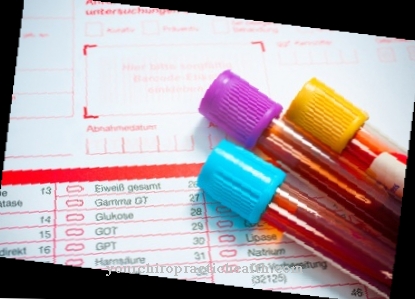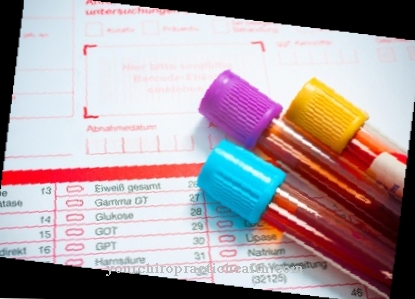At Cyclooxygenases they are enzymes that are involved in the formation of prostaglandins. These in turn cause inflammation.
What are cyclooxygenases?
The cyclooxygenases (COX) are enzymes. They are involved in the arachidon metabolism. There they catalyze the production of thromboxanes and prostaglandins. The COX enzymes play a key role in regulating inflammation.
Cyclooxygenase has been known to man since the 1930s. The first purified production of cyclooxidases took place in the 1970s from tissue homogenates from sheep and cattle. From 1972 onwards, speculation began as to whether there was more than one cyclooxygenase. In the 1990s, the protein structures of cyclooxygenase-1 and cyclooxygenase-2 could be sequenced. The two isoenzymes differ from one another in their gene locus. In addition, their structures were clarified, which could be used to produce drugs that affect the enzymes.
Function, effect & tasks
The cyclooxygenases are divided into two subspecies. These are cyclooxygenase-1 (COX-1) and cyclooxygenase-2 (COX-2). These are two different forms of the enzyme. Their amino acid is 68 percent identical. There is also evidence that another cyclooxygenase exists, known as cyclooxygenase-3.
COX-1 and COX-2 play an important role in therapeutic medicine. Cyclooxygenase-1 is an enzyme that is constitutively expressed. It also synthesizes prostaglandins to a greater extent within a healthy body. Larger amounts of COX-1 are found primarily in the kidneys and the stomach wall. The expression of COX-2 occurs particularly in tissues that are inflamed or damaged. This is where the prostaglandins are produced. These either maintain inflammation or even intensify it.
The function of the cyclooxygenases is to catalyze the conversion of arachidonic acid into prostaglandin H2. This also applies to eicosapentaenoic acid (EPA) and dihomogammalinolenic acid (DGLA). The process takes place in two steps, which take place in the reaction centers of the enzyme. Step 1 is done in the catalytic center. It consists of a ring closure between the carbon atoms C8 and C12. In addition, two oxygen atoms are inserted at C9 and C11. These then enter into a covalent bond with one another, as a result of which a peroxide bridge is formed in the prostaglandin G2. The prostglandin-G2 that has arisen can diffuse out of the channel.
The second step takes place through catalysis of the reaction center with peroxidase activity. The prostaglandin H2 is created from the prostaglandin G2. This ensures the synthesis of further prostaglandins.
Education, occurrence, properties & optimal values
Cyclooxygenases are located in the inner section of the endoplasmic reticulum, in the interior of the nuclear envelope and in the Golgi apparatus. In the process, they adhere to the inner sides of the cell compartment membranes. They are also present in the cells of animals. In contrast, they do not occur in insects, plants or unicellular organisms. However, they contain related enzymes such as pathogen-inducible oxygenases.
COX-1 is found in the endothelial cells of normal blood vessels, while COX-2 is found in the endothelial cells of proliferating blood vessels of inflamed tissues. In addition, COX-2 is often present in tumor cells where it is proliferating. Doctors suspect that the enzyme contributes to the growth of a tumor. In the brain, too, COX-2 is produced to an increased extent as part of inflammation. The enzyme is found in the endothelial cells of the hypothalamic vessels. The fever-inducing PGE2 is formed. Occasionally, COX-2 also arises in nerve cells and glial cells.
Within the kidneys, cyclooxygenase-2 is primarily contained in the macula densa. This leads to an increased production of prostacyclin, which starts the formation of the enzyme renin. COX-2 is always present in the spinal cord. There it is used to process pain stimuli.
Diseases & Disorders
The cyclooxygenases play an important role in diseases, which is especially true for the cyclooxygenase-2. In the course of inflammatory processes, COX-2 is transcribed more intensely.
So-called COX-2 inhibitors are administered to treat the symptoms that are related to it, such as pain and fever. These are anti-inflammatory drugs that belong to the group of non-steroidal anti-inflammatory drugs (NSAIDs). In contrast to the classic antipyretics, which have an effect on both COX-1 and COX-2, the COX-2 inhibitors concentrate on blocking cyclooxygenase-2.
Often, COX-2 is found in malignant cancer tumors. The prostaglandins such as PGE2, which arise in the tumor tissue, directly influence the tumor cells and the tumor stroma. For this reason, cancer research is placing hopes on a positive effect of COX-2 inhibitors, which is especially true for cancers of the gastrointestinal tract. These drugs attack both the invariable stroma and the highly variable cells of the tumor. This reduces the likelihood of developing resistance.
It has not yet been possible to clarify which functions cyclooxygenase-2 plays in the brain cells. That is why the question of whether prolonged use of COX-2 inhibitors has a physiological effect on the brain remained unanswered. However, numerous stimuli cause COX-2 to develop in nerve cells, astrocytes and microglia. These include epileptic seizures, inflammation, hypoxia, and toxins that have an excitatory effect. However, the effects of this process are still unclear. Doctors also suspect an influence of cyclooxygenases on the development of Alzheimer's disease.
The main cyclooxygenase inhibitors used are anti-inflammatory drugs, analgesics, anti-inflammatory drugs and antipyretics. These include a. Acetylsalicylic acid and ibuprofen.






.jpg)





.jpg)



.jpg)










.jpg)
